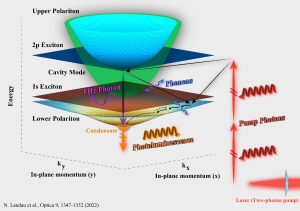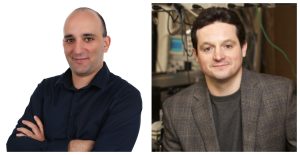Two-Photon Absorption into a Quantum Condensate
Observed for the first time, achievement may accelerate research in quantum information processing, biological sensing, and more.
An experimental achievement by researchers at the Technion – Israel Institute of Technology in the field of quantum condensation may accelerate research in quantum information processing and developments in security, biological sensing, wireless communication, and more. Published recently in Optica, the research was led by doctoral student Nadav Landau and Professor Alex Hayat from the Andrew and Erna Viterbi Faculty of Electrical and Computer Engineering at the Technion and conducted in collaboration with colleagues in Germany.
Quantum condensation is a physical phenomenon in which a large number of matter particles maintain coherence over time and space – a very important feature for many of the quantum technologies being developed today. Optically excited quantum condensation has been achieved so far only through one-photon absorption – a process in which one photon excites a matter particle to a higher energy state, where condensation then occurs.
Two-photon absorption, on the other hand, is a process where two photons are simultaneously absorbed to excite a matter particle, bringing about many scientific and technological advantages. Among other things, it is essential for long-term quantum memory applications. The states of matter that can be reached in such a process are characterized by very low emission of light, and in this context are thus called “dark states.”
To observe two-photon absorption leading to condensation, unique experimental conditions that have not been achieved so far due to complex technological and scientific challenges are necessary. Extremely high-power lasers and ultra-short pulses in time are needed to avoid heating. The Technion researchers overcame these challenges, and in the article they present quantum condensation from a two-photon absorption process in a semiconductor chip. This achievement paves the way for new, practically-realizable quantum technologies by coupling “dark states” to quantum condensates on a solid-state platform.
One of the promising applications of this breakthrough is the realization of very efficient laser sources in the terahertz (THz) range of electromagnetic radiation. Such sources are vital for many applications in fields such as biological sensing, security, materials science, and communication, but finding them has been a notoriously difficult challenge for many years due to fundamental physical reasons.
The result the researchers observed can, in principle, enable the achievement of orders-of-magnitude increased THz emission through a process of doubly stimulated emission.

Energy band diagram of a gallium arsenide (GaAs)-based semiconductor microcavity as studied in the experiment, in which quantum condensation of light-matter coupled quasi-particles called Exciton-polaritons is achieved via two-photon absorption. The achievement paves the way for novel coherent control schemes and the realization of an efficient laser source in the terahertz (THz) range of electromagnetic radiation.
The research was supported by the Israel Science Foundation (ISF).
To read the full paper, click here



